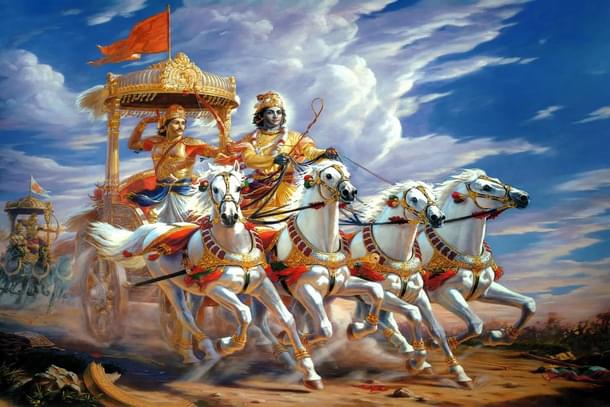Commentary
Why The Bhagavad Gita Should Be Taught In Schools
Venu Gopal Narayanan
Jan 11, 2023, 06:07 PM | Updated 06:05 PM IST
Save & read from anywhere!
Bookmark stories for easy access on any device or the Swarajya app.


A needless row has broken out in Karnataka after the state government decided that Bhagavad Gita would be taught in schools there.
Although the official announcement was made in April 2022, it has been brought to the fore only now by the usual corners.
The reason is obvious: assembly elections are due in a few months. Yet, for once, this is a good brouhaha to have, because it also puts an inadequately-discussed topic in the spotlight: how might Indians teach Indian children Indian ethics so that they may lead an Indian way of life
This is one of the problems caused by a legislative codification of secularism, which is long-overdue for solving.
Right from when the Constitution was voted into effect, a key fallout was that selected communities (called ‘minorities’ for purely political reasons and no other), were permitted to establish their own educational institutions, while the rest, the ‘majority’, had to stick to an anodyne system in which Indian children were taught everything but their actual way of life.
Or, to put it in colloquial words, those who followed Sanathana Dharma, lost the option to teach their children the basic principles of their way of life in an organized manner.
Of course, there are a number of private organizations, like the Chinmaya Mission, who have established extensive networks of schools across the country, but these are no more than a drop in the ocean, when we consider the numbers. Besides, they are also constrained by the standard curriculums which have to be followed.
As a result, the ethics, morals, and civics Indian children learn in school, are largely derived from concepts alien to them, via an imported pedagogy. Even our culture and history are taught as topics to be learnt by rote for mindless reproduction sans error at exam time.
We might as well teach our children about Polynesians or Aztecs, because, in this gargantuan exercise to churn out good citizens, the one thing they hardly ever get to learn is a code of social behaviour rooted in the civilizational ethos of their land.
The problem becomes more acute as urbanization and migration have put the joint family system on notice, and thereby reduced possibilities for additional learning the traditional way — from family elders.
No wonder cultural detachment happens so easily to our youngsters: if they didn’t learn it at school, and don’t have a supportive system at home, then why complain when they cheer for the tukde-tukde gang, or spout utter inanities like ‘gender is a spectrum’?
Therefore, the Karnataka government’s decision should be seen for what it is — one more baby step in dismantling a colossal edifice established some centuries ago, with the specific, stated purpose of producing individuals who swore fealty to abstractions which had nothing to do with the mores of this land.
And yet, because it was, and still is, such an extensive, all-encompassing structure which decides the future of every child, there is no escaping it — yet.
Now, it is inevitable that shrieks of alarmist horror will mount over the prospects of the Bhagavad Gita being taught in schools, and their decibel levels will rise exponentially as the Karnataka assembly elections draw closer. Already, the move has been labelled as an ‘un-secular’ ploy to sneak ‘fascist, majoritarian, Hindutva’ into classrooms.
Thus, it is important that these canards be exposed at the outset, to prevent alarmism from gaining any further credence, and before a relentless, vitiating atmosphere turns school grounds into battlegrounds, like the Hijab episode did last year.
And one way to do that is by outlining intentions and modalities, to reassert their benign and socially-beneficial nature.
What are the standard objectives of teaching ethics in schools?
Very simply, to teach children how to live in their society by doing their duty, knowing the difference between right and wrong, and following basic principles of right conduct which, in reality, have nothing to do with ‘religion’.
Now, if the logic and ethics of Aristotle are employed for that purpose in Indian schools (the Greek philosopher’s influence on Western thought, which forms the basis of prevailing liberal thought in India, is second to none), then why not, for example, the logic and ethics of the epics (the Bhagavad Gita is an integral part of the Mahabharata)?
And how might that teaching progress across twelve years of schooling? In primary school, focus would be on the epics, with storylines and interesting factoids providing frames of reference to curious young minds. Nothing teaches morals better than a parable children can relate to.
Mapping locations from the epics would not just teach them geography and a little history, but also explain the actual, unbroken antiquity of the land they were born in. Additionally, learning the sounds of the texts, and using them in skits, would improve diction, enhance vocabularies, and inspire more to choose Sanskrit as a second language.
In secondary school, concepts would be added to details, to make students think. Was Sri Rama right to kill Vali? Was Ravana a uni-dimensional Bollywood-esque villain, or was there more to him? The list of topics is almost endless, with no single, dogmatic, correct answer; and each episode would demonstrate that the world is anything but a binary black-and-white.
Essays, skits, debates, and comparative analyses of different versions, along with tours to the places they learnt about in primary school, would not just root them further to their land, but show as well, that nothing is cast in stone.
It would also automatically prepare a generation to easily contest the ideological rigidity we suffer currently.
By the time they reach higher secondary school, not only would the Gita be studied on a stand-alone basis, but various schools of philosophy would be introduced as well.
That transition phase from child to adult would be an ideal one in which, for example, Adi Shankaracharya’s timeless achievement of knitting the Gita, the Upanishads, and the Vedas together, using Vedanta, is taught.
Youngsters would be primed, and ready, to learn what Dharma actually means, its importance in daily life, and the tools — right thought and right action — required to uphold it in society without confusion in one’s mind.
Thus, to summarize, such a curriculum would reinforce a youngster’s connection with this land, grasp the subtler aspects of subjectivity, improve reasoning ability, improve scientific temper through the focus on logic from their formative years, make them less prone to deracination, prevent the growth of a blinkered, binary outlook, and realize the actual, practical meaning of their way of life.
And all of the above would be firmly bolstered by those middle-class values, which form the foundation of our society.
Why, then, would anyone object to the Bhagavad Gita being taught in schools? That is a question to which there is no logical answer.
Venu Gopal Narayanan is an independent upstream petroleum consultant who focuses on energy, geopolitics, current affairs and electoral arithmetic. He tweets at @ideorogue.





